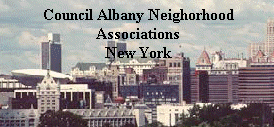Members suggested that the campus, or part of it, be
developed for community use.
The comment was made that the proposed plan has a look to
it that emulates a shopping center and that more green space
would be desirable.
The Campus is very difficult to negotiate. The ring roads
are confusing and, unless you are familiar with them, can be
dangerous to maneuver. Additionally they keep the Campus
isolated. It does not appear to be a destination for anyone
who does not work there. It needs to be inviting.
Another effect of the ring roads is that they lead into
the major highways. Many workers at the Campus do not use
the roads that lead to the neighborhoods and businesses.
Therefore, better integration of the Campus into the
community via infrastructure and public transportation is
desirable.
Removal of the ring roads is unlikely because of the
expense to demolish them. It is anticipated that if the
Campus becomes part of a research and development
partnership with SUNY, roadways providing direct access
between the two campuses will be built.
The number of people working at the location will be
approximately the same.
Concern about the possible congestion of traffic in the
area was raised, particularly in light of the proposed site
of Albany’s new middle school so close to the Campus.
Better access by public transportation should be offered as
well as incentives for employees at the site to car pool.
Members expressed concern about Albany’s ownership in
the plan and what benefits it will receive from
redevelopment of the Campus. Implementation of any
redevelopment strategy will require that a partnership be
formed between OGS, SUNYA, and ESDC, and the authors of the
study have recommended the formation of a quasi-public
development entity to combine the resources of the three
participants. That development corporation will be comprised
of residents of Albany, representatives from SUNYA, NYS,
ESDC, and government leaders from the City of Albany.
Although the City’s role is not yet defined, it will have
a formal role in planning and implementation. The City and
its residents are encouraged to read the plan (available on
the CANA website) and become active participants. OGS
welcomes comments via letter, email (public.information@ogs.state.ny.us)
or telephone calls. A link to the website will be sent to
Howie Stoller and made available to CANA members.
The City is likely to receive $60 million over 20 years
if the Campus is redeveloped into a tech park.
The type of research and development proposed will not be
intrusive to the surrounding neighborhoods.
Some types of research being considered include thin
films, nano sciences, atmospheric sciences, genomics, fuel
cells, molecular research, neurobiology, and plasma
research.
None of the land either on the Campus or at SUNY located
in the Town of Guilderland.
A draft timeline is being developed for publication prior
to public hearings and the SEQR process.
The student housing presently under construction on the
SUNY campus was not planned in partnership with the City of
Albany. Members requested and received assurances that
Albany would participate in the redevelopment process and
not simply be asked to approve a plan subsequent to its
development.
Use as residential housing has not been excluded although
is difficult for the planners to envision.
The consultants have conducted extensive interviews with
Albanians in order to include their views in the final plan.
Successful research parks in the cities of Boston, New
Haven, Worcester, Richmond Cambridge, and North Greenbush
were analyzed as models for the SUNY tech park.
Amenities such as retail and eating establishments are
planned in the model for the new work force that is expected
to populate the proposed tech park.
